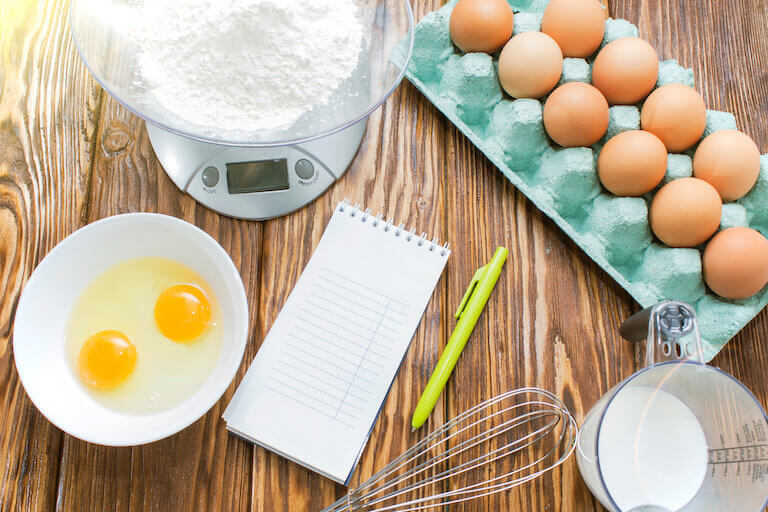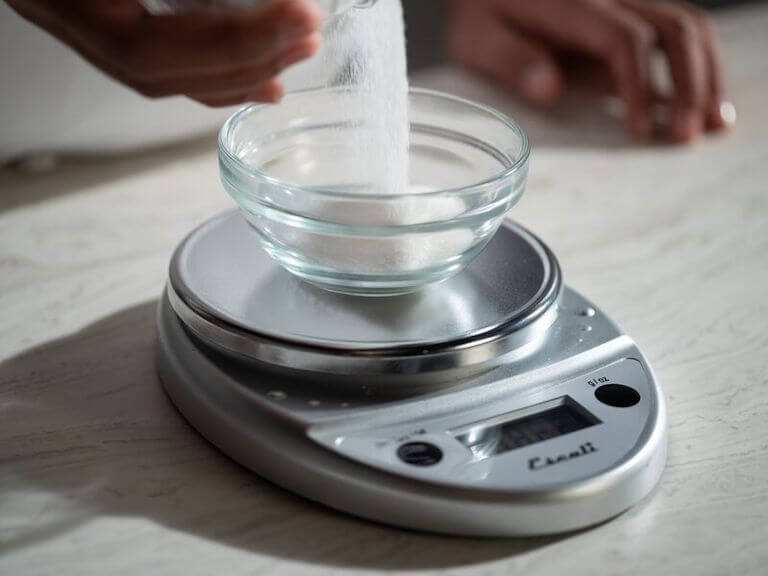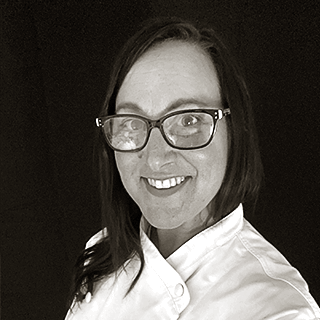Ever found yourself staring at a recipe, wishing it came in a “party size” edition? Or maybe you’ve stumbled upon a dish so delicious, you just had to make a week’s worth for meal prepping.
The challenge is, you can’t always double or triple a recipe and get the same results. Some recipes, like soups and stews or pasta dishes and salad, are easy because their ingredients are generally straightforward and include flexible ingredient ratios. Others, like when baking, involve complex chemistry, some math, and ingredients that are sensitive to changes in quantity.
But once you discover how to properly scale a recipe, you can be more versatile and economical, and you can save time and money.
Read on to explore the fundamentals of scaling up recipes and cooking for a crowd.

Scaling up recipes is simple if you determine your serving size and write down your adjustments.
Follow These Essential Steps to Scale Up Your Recipes
When attempting to scale up a particularly challenging recipe, it’s crucial to plan meticulously, test your scaled-up recipe if possible before you plan to serve it, and be prepared for some trial and error.
Be sure to take notes and write down any adjustments you make, both in terms of ingredients and cooking times. This will help make sure you’ve got the correct calculations in the future.
Here are the basic steps to help make sure your food properly scales without sacrificing quality:
1. Determine Your New Serving Size
The first step to scaling up your recipe successfully is to determine your number of desired servings. Identify how many servings the original recipe makes, and note how many servings you need for the scaled-up version.
2. Calculate the Scaling Factor
Next, it’s time to determine the scaling factor that will be used to help you calculate your new serving sizes. To do this, divide the desired number of servings by the original number of servings. For instance, if the original recipe serves four and you want to make it for 12, the scaling factor would be 12/4=3.
3. Use the Metric System Whenever Possible
It’s much easier to scale up recipes when you have weight-based measurements for all of your ingredients, like grams (metric system) or ounces (Imperial system). Because the numbers are based on tens, metric measurements like grams and kilograms can be easier to calculate than Imperial measurements, which rely on things like ounces and pounds that divide into each other at more complex intervals.
That also means you should consider investing in a good kitchen scale. This will help you find exact measurements based on weight instead of scooping ingredients into a measuring cup, which can vary by person or material. Look for a scale that’s sensitive to at least one gram or lower.
For each ingredient in the original recipe, multiply the quantity by the scaling factor and use a kitchen scale to weigh the adjusted quantities in the appropriate metric units (grams, milliliters, etc.).

A good kitchen scale can help you adjust recipes accurately and ensure a familiar final product.
4. Consider Your Specific Ingredients
It’s important to keep in mind that some ingredients might not scale linearly. For instance, when doubling a bread recipe, it might not be necessary to double the yeast. It’s best to double-check the specific ingredients for your recipe online to ensure they scale linearly. And if you have a weight-based measurement for something like eggs, you might need to whisk them together before getting an accurate measurement of components like whites and yolks in equal portions.
Also, be cautious when scaling up spices, salt, and strong flavorings. Instead of multiplying, you might want to increase them by a lesser factor and adjust to taste.
5. Adjust Cooking Time and Temperature
As you increase the size or volume of a dish, it may require more or less time to cook. This is especially true for baked goods. For larger volumes, you might need to start checking for doneness earlier. While the oven temperature generally remains the same with a larger recipe, there are exceptions. Large cakes or casseroles might benefit from a slightly reduced temperature to ensure even cooking without burning the edges.
6. Consider the Size of Your Cookware
When you scale up a recipe, you might need to use a larger pan or multiple pans. Ensure that the depth of the food remains relatively the same to ensure even cooking. For example, if you double a cake recipe, consider using two cake pans of the same size rather than a single large one.
What a Scaled-Up Recipe Looks Like (It’s Cookies!)
Remember, although the math behind scaling is straightforward, the actual cooking process can have some nuances depending on your specific recipes. Trust your instincts, and don’t be afraid to make small adjustments as needed. Below is an example of a baking recipe that can be scaled using this technique.
Let’s say you have a recipe for a cake that makes eight servings, and you want to scale it up to make 16 servings. You’ll need to double the recipe. Here’s the original recipe:
Original Recipe (8 servings):
- 200 grams of all-purpose flour
- 150 grams of granulated sugar
- 100 grams of butter
- 2 eggs
- 1 teaspoon of baking powder
- 1/2 cup of milk
- 1 teaspoon of vanilla extract
Now, let’s scale up this recipe to make 16 servings:
Determine the scaling factor: To double the recipe (from 8 servings to 16 servings), the scaling factor is 16/8, which is 2. This means you’ll need to multiply each ingredient by 2.
Scale up the ingredients:
- All-purpose flour: 200 grams x 2 = 400 grams
- Granulated sugar: 150 grams x 2 = 300 grams
- Butter: 100 grams x 2 = 200 grams
- Eggs: 2 eggs x 2 = 4 eggs
- Baking powder: 1 teaspoon x 2 = 2 teaspoons
- Milk: 1/2 cup x 2 = 1 cup (240 ml)
- Vanilla extract: 1 teaspoon x 2 = 2 teaspoons
Adjust units if necessary
In this example, you may want to convert the milk measurement from cups to milliliters, as 1 cup is approximately 237 ml.
Follow the same preparation and cooking instructions as in the original recipe but using the scaled-up quantities.
The Confidence To Cook For Any Crowd
Being able to multiply ingredients while maintaining the original essence and flavor of a dish is a crucial skill for an aspiring chef , especially when unexpected guests arrive or you’d like to share a recipe with a larger group. Beyond being able to share your recipes with groups of any size, understanding how to scale up recipes helps develop a deeper understanding of ingredient ratios, cooking techniques, and the chemistry of food.
Receiving a culinary education through Escoffier degree and diploma programs can help you grow your expertise as a home chef and enhance your ability to create, innovate, and share your culinary passion with a larger audience. It might even lead to an exciting career in the culinary or pastry arts!


